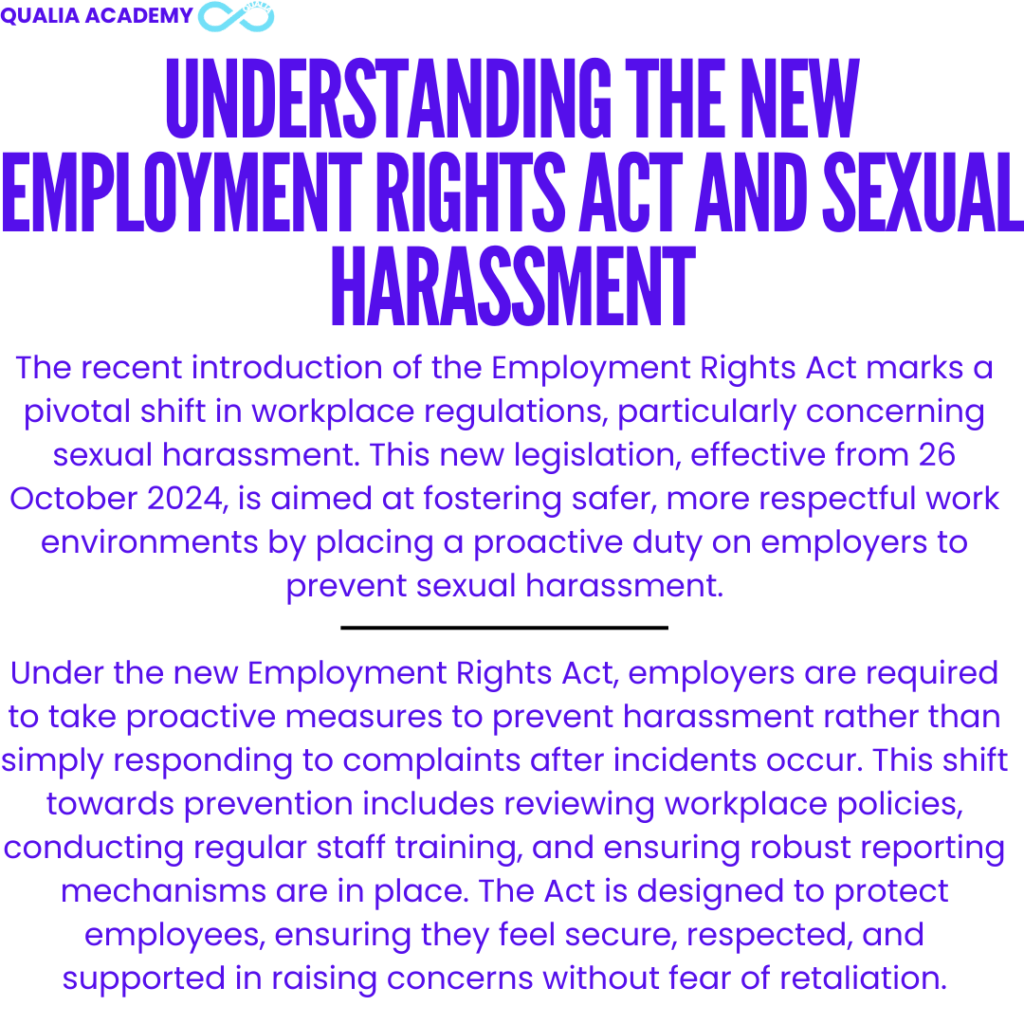Understanding the New Employment rights act and Sexual Harassment
The recent introduction of the Employment Rights Act marks a pivotal shift in workplace regulations, particularly concerning sexual harassment. This new legislation, effective from 26 October 2024, is aimed at fostering safer, more respectful work environments by placing a proactive duty on employers to prevent sexual harassment.

Under the new Employment Rights Act, employers are required to take proactive measures to prevent harassment rather than simply responding to complaints after incidents occur.
This shift towards prevention includes reviewing workplace policies, conducting regular staff training, and ensuring robust reporting mechanisms are in place.
The Act is designed to protect employees, ensuring they feel secure, respected, and supported in raising concerns without fear of retaliation.
Key Provisions of the Act
Proactive Duty on Employers
One of the most significant aspects of the new Act is the proactive duty placed on employers to prevent sexual harassment. This means that employers are now legally required to take reasonable steps to safeguard their employees from harassment.
These steps can include implementing comprehensive anti-harassment policies, conducting regular training sessions, and establishing clear reporting mechanisms.
The Act recognises that creating a safe work environment is not just about responding to incidents after they occur but about fostering a culture where harassment is unlikely to happen in the first place.
This proactive approach is a substantial departure from previous regulations, which often placed the burden on victims to report incidents.
The Equality and Human Rights Commission (EHRC) provides guidelines on what constitutes “reasonable steps.” According to the EHRC, reasonable steps could include comprehensive policies that clearly outline unacceptable behaviour and the consequences of such actions.
These policies should be regularly reviewed and updated to ensure they remain effective. Regular training sessions should be provided for all employees, including senior management. These sessions should cover what constitutes sexual harassment, how to report it, and the support available to victims.
Employers should regularly monitor the workplace environment to identify any potential issues and take proactive steps to address them. This could include anonymous surveys and feedback mechanisms to gauge employees’ experiences and perceptions.
Enhanced Protection for Employees
The Act also extends protections to cover third-party harassment, which is particularly relevant for industries with high levels of customer interaction, such as hospitality and retail.
Under the new regulations, employers are responsible for protecting their employees from harassment by customers, clients, and other third parties.
This acknowledges the unique challenges faced by workers in these sectors and ensures that they have the same protections as those working in more traditional office environments.
To address third-party harassment, employers might consider clear reporting mechanisms so employees know how to report incidents of harassment by third parties and feel confident that their complaints will be taken seriously and addressed promptly.
Employers could introduce codes of conduct for customers, clearly stating that harassment of staff will not be tolerated. Visible signage and communication to customers can help reinforce this message. Providing support systems for employees who experience harassment is crucial. This could include access to counselling services, support groups, or legal advice.
Increased Accountability
Employers who fail to comply with the new regulations may face significant penalties. The Act includes provisions for an uplift of up to 25% in compensation awarded by employment tribunals in cases where the employer is found to have failed to take reasonable steps to prevent harassment.
This serves as a powerful incentive for employers to take their responsibilities seriously and to ensure that they are doing everything possible to protect their employees.
Employers should conduct risk assessments, regularly assess the risk of harassment occurring in the workplace and implement measures to mitigate these risks. This could include reviewing workplace layouts, staffing levels, and shifts to ensure employees are not put in vulnerable situations.
They should keep detailed records of any incidents of harassment and the steps taken to address them. This documentation can be crucial in demonstrating that the employer has taken reasonable steps to prevent harassment. Employers should periodically review policies and procedures to ensure they remain effective and make any necessary adjustments based on feedback and changing circumstances.
Practical Steps for Employers to Ensure Compliance with New Regulations
Review and Update Workplace Policies
Employers must review and update their workplace policies to align with the new regulations. Ensure that these policies clearly outline procedures for reporting and addressing sexual harassment.
If current policies are lacking, consider implementing new ones. All policies should be communicated to employees so they understand their rights and responsibilities under the new Act.
Conduct Regular Training Sessions
Regular training is key to compliance. Employers should provide sessions that educate employees about their rights, responsibilities, and the process for reporting harassment. Refresher courses should be offered to keep everyone informed of any updates to the regulations.
Identify Harassment and Clarify Reporting Procedures
Training should help employees recognise different forms of harassment, including subtle behaviours that contribute to a hostile environment.
Clear reporting procedures must be established so employees know how to report harassment and feel comfortable doing so. Bystander intervention training can empower staff to act and prevent escalation.
Establish Safe and Accessible Reporting Channels
Employers should create accessible and secure ways for employees to report harassment, ensuring they can come forward without fear of retaliation. Options could include hotlines, anonymous reporting systems, or designated contacts within the organisation to handle complaints.
Maintain Confidentiality and Build Trust
Confidentiality is crucial to ensure privacy and encourage employees to report issues. Offering multiple reporting methods, such as in-person, via email, or through a hotline, gives employees flexibility.
Keeping them informed about the progress of investigations builds trust and shows that their concerns are being taken seriously.
Case Studies Within Different Industries
Retail Industry
In a recent case, a major retail chain faced significant penalties after failing to protect its employees from harassment by customers. The company had not implemented any specific policies or training related to third-party harassment, leading to multiple incidents where employees were subjected to inappropriate behavior from customers.
The employment tribunal ruled in favour of the employees, awarding them compensation with an uplift of 25% due to the company’s failure to take reasonable steps to prevent harassment.
The case highlights the importance of proactive measures, such as implementing customer codes of conduct or providing training to staff on how to handle harassment from customers.
It also emphasises having clear policies in place that address third-party harassment and outline the procedures for reporting and addressing incidents, along with providing support for employees who experience harassment, including access to counseling services and legal advice.
Hospitality Sector
A well-known hotel chain implemented a comprehensive anti-harassment policy and conducted regular training sessions for its staff. Despite these efforts, an incident occurred where a guest harassed a hotel employee.
The employee reported the incident through the established reporting mechanism, and the hotel took immediate action to address the issue.
The tribunal recognised the hotel’s proactive approach and awarded no uplift in compensation, highlighting the importance of having effective policies and training in place.
This case demonstrates the value of effective training, ensuring that employees are aware of their rights and know how to report harassment.
It also shows the importance of a proactive response to incidents, including taking immediate action to address the issue and support the employee. Regularly reviewing and updating policies and procedures to ensure they remain effective and reflect best practices is also essential.
The Historical Context
Understanding the historical context of workplace harassment laws can provide valuable insights into the significance of the new Employment Rights Act. Historically, workplace harassment, particularly sexual harassment, was often overlooked or inadequately addressed.
The legal landscape began to shift in the latter half of the 20th century, with significant milestones such as the Sex Discrimination Act 1975 in the UK, which made it unlawful to discriminate on the grounds of sex or marital status.
Despite these legislative efforts, workplace harassment persisted, highlighting the need for more robust measures. The introduction of the Equality Act 2010 was a significant step forward, consolidating previous anti-discrimination laws and providing a comprehensive legal framework to protect individuals from discrimination, harassment, and victimisation.
The new Employment Rights Act builds on this foundation, introducing proactive measures to prevent harassment before it occurs. By placing a duty on employers to take reasonable steps to prevent harassment, the Act aims to create a more equitable and respectful workplace environment.
International Comparisons
Looking at international regulations can provide further insights into the effectiveness of different approaches to workplace harassment. For instance, the United States has the Title VII of the Civil Rights Act of 1964, which prohibits employment discrimination based on race, colour, religion, sex, and national origin.
The U.S. Equal Employment Opportunity Commission (EEOC) enforces these laws and provides guidance on preventing workplace harassment.
In contrast, countries like Sweden and Norway have taken a more proactive approach, focusing on creating inclusive workplaces through comprehensive anti-harassment policies and training programs. These countries have seen positive results, with lower rates of reported harassment and higher levels of employee satisfaction.
The new Employment Rights Act in the UK aims to emulate the success of these international models by placing a proactive duty on employers to prevent harassment. By adopting best practices from around the world, the Act seeks to create a safer and more respectful work environment for all employees.
The Role of Technology in Preventing Harassment
Technology can play a crucial role in helping employers comply with the new regulations and create a safer work environment. Here are some ways technology can be utilised:
Anonymous Reporting Systems: Digital platforms can provide employees with the ability to report harassment anonymously, ensuring their privacy and encouraging more individuals to come forward.
AI Monitoring Tools: Artificial intelligence tools can monitor workplace communications for signs of harassment and flag potential issues for further investigation.
Online Training Platforms: Employers can utilise online platforms to deliver comprehensive training sessions to employees, ensuring that everyone understands their rights and responsibilities under the new Act.
Digital Policy Management: Technology can help manage and distribute updated policies to all employees, ensuring that everyone is aware of the latest regulations and procedures.
Future Developments
The introduction of the Employment Rights Act is just the beginning. There will likely be ongoing discussions and developments that could lead to:
Broader definitions of harassment to cover a wider range of behaviors.
Increased support for victims, including additional resources for counseling and legal assistance.
Stronger penalties for non-compliance, ensuring that employers take their responsibilities seriously.
The new Employment Rights Act represents a crucial step forward in the fight against workplace sexual harassment. By placing a proactive duty on employers, it aims to foster a culture of respect and safety in all work environments. Employers must take immediate action to comply with these regulations, ensuring their workplaces are free from harassment.
This Act marks a significant milestone in ongoing efforts to combat workplace harassment, fostering a proactive approach to prevention and creating safer, more respectful, and equitable work environments for all.
Here at Qualia Academy, we provide learning courses on a range of topics on our Qualia Learning Hub that are essential to know about, we ensure all our apprentice’s have taken these courses. We offer a learning course on sexual harassment.
Contact us if you are interested in our learning courses.









